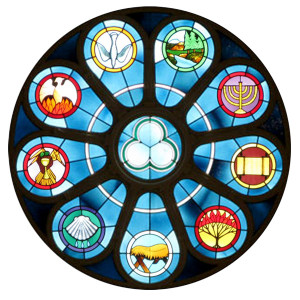This mandala is from Eastminster Presbyterian Church, Dallas, Texas. Though this is a modern building, their stained glass window is an excellent example of a Christian Mandala. It also has one unusual feature that I have not seen in other stained glass windows.
At a high level the window has a trefoil or Christian Trinity Symbol in the center of the circle. The nine circles at the outer radius of the mandala contain symbols which essentially unpack the work of the Trinity over time. It is a very nice piece of art, and summarizes Scripture in a very compact way.
The number nine is unusual for a Christian Mandala or a stained glass window. After going through the individual outer symbols we will try to understand the meaning intended by the number nine.
Beginning at the top around the 1:00 O’clock position and moving clockwise.
- Creation. Creation is depicted here as a mountain, trees, and a river. This is non-standard Christian symbolism. Typically the number six or a six pointed star is used. Still, I like this image as it calls to mind the beauty of the world God created for us, and communicates the intent.
- The Menorah. This is an ancient candlestick made of pure gold. It has a main trunk with six branches giving a total of seven lights. The Menorah was placed in the tabernacle, i.e., the mobile temple used in the days of Moses. The Menorah was the only source of light in the Holy Place of the tabernacle so it traditionally symbolizes the divine light of God.
- Scroll. Typically, a scroll is used as a symbol for Old Testament writings, or a prophet. Here, Eastminster is using the Scroll to represent the 10 commandments. More commonly, two tablets are used to represent the 10 commandments.
- Burning Bush. The burning bush is a classic Old Testament symbol of God’s revelation of Himself. I AM WHO I AM. Eastminster indicates that they are using the Burning Bush as a symbol of the work of the Prophets. This is somewhat of a non-standard usage of the symbol.
- Manger scene. The little bed filled with hay is being used as a symbol for the birth of Jesus. A more common symbol is a four pointed star, but this element gets the message across nicely.
- Shell and three drops. Absolutely the classic Christian symbol for the Baptism of Jesus.
- Chalice. The Eastminster description says wheat and chalice. The image is a bit hard to read, but I see a chalice, grapes, and very stylized wheat. The chalice is a classic Christian Symbol used for Holy Communion.
- Phoenix. Here again is a classic Christian Symbol for the resurrection of Christ.
- Descending dove. This is a classic Christian Symbol for the coming of the Holy Spirit.
The mandala uses a mixture of classic Christian Symbols and new symbols. Some of the classic Christian Symbols are used in a non-traditional way. Still, the mandala succeeds in giving us a compact visual narrative of Scripture, or as Eastminster puts it: “…the unfolding of the revelation of God.” Well done.
So nine symbols on the periphery. Classically, most sources associate the number nine with angels. Nine may have been chosen because it was a multiple of three, or because it gives a somewhat less symmetric design. Other ideas may arise from dividing the circle into 40 degree sections. Hmmm…. The diameter of the circle surrounding the central trefoil is very close to the same diameter of the circles surrounding each of the symbols. This would give 10 equally sized circles. 10 is the number of completion, and my best guess at the intent.

